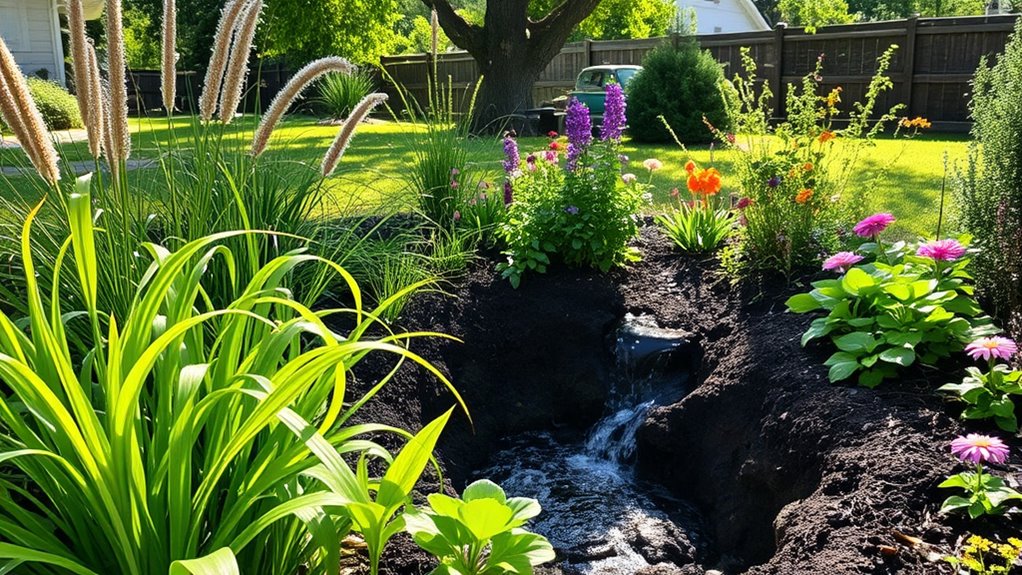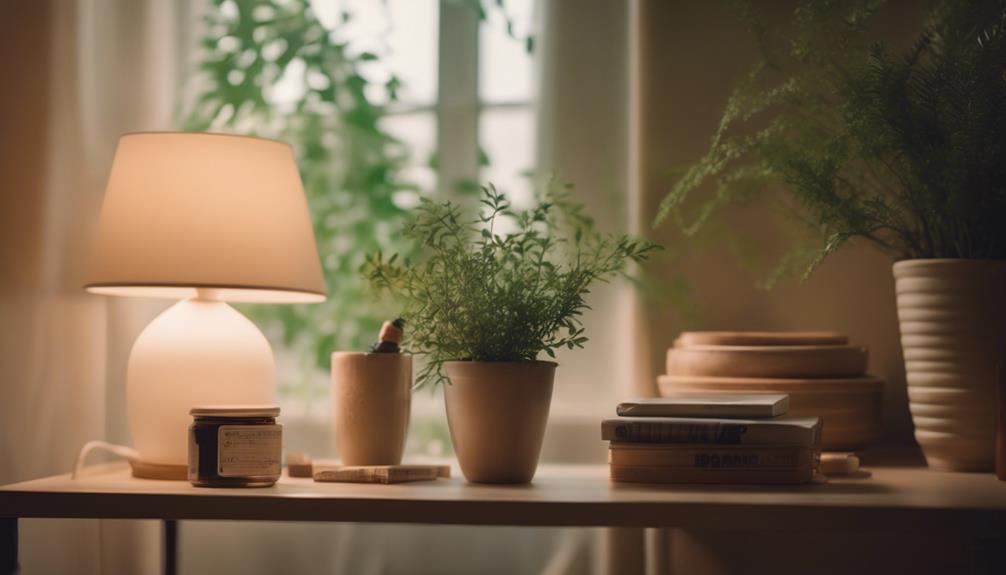A rain garden is a shallow, planted basin designed to capture and filter stormwater runoff from your yard. By directing water into this natural basin, you prevent pooling, reduce erosion, and improve water quality. Native plants, carefully selected for your region, thrive in these gardens, attracting beneficial insects and supporting local wildlife. To create one, choose a strategic location, shape the basin, and plant native species. Keep exploring to discover how to turn your yard into a sustainable oasis.
Key Takeaways
- Rain gardens are shallow, planted depressions that absorb and filter stormwater runoff, preventing flooding and improving water quality.
- Proper location and size are crucial; choose areas where water naturally flows and keep away from foundations and underground utilities.
- Use native plants like grasses, perennials, and shrubs to ensure adaptability, low maintenance, and support for local wildlife.
- Amend soil with sand or compost and mulch to enhance drainage, retain moisture, and suppress weeds for a thriving garden.
- Rain gardens create a beautiful, natural habitat that attracts pollinators and benefits the environment while managing stormwater effectively.

Have you ever wondered how to manage stormwater while beautifying your yard? Creating a rain garden is an excellent way to do both. A rain garden is a shallow, planted depression designed to absorb and filter stormwater runoff. When it rains, instead of overwhelming your sewer system or pooling in unwanted areas, the water naturally soaks into the ground through your rain garden. This process is called stormwater management, and it helps reduce erosion, prevent flooding, and improve water quality. Plus, it adds beauty and diversity to your landscape.
Creating a rain garden helps manage stormwater, prevent flooding, and beautify your landscape naturally.
The secret to a successful rain garden lies in selecting the right plants. Native plants are your best choice because they’re adapted to your region’s climate and soil conditions. These plants thrive with less watering and maintenance, making your rain garden sustainable and low-cost. Native plants also attract beneficial insects and pollinators, adding a lively, natural vibe to your yard. By choosing a mix of grasses, perennials, and shrubs native to your area, you create a resilient, thriving ecosystem that supports local wildlife.
Designing your rain garden begins with identifying a suitable location. Pick a spot where water naturally flows or collects during storms, ideally at least ten feet away from your home’s foundation. You want to avoid areas with existing drainpipes or underground utilities. Once you’ve chosen a location, determine how large your garden should be based on your typical rainfall and the impervious surfaces that generate runoff. A general rule of thumb is that your rain garden should be roughly 20-30% of the impervious area draining into it.
Next, you’ll dig a shallow basin, about 4 to 8 inches deep, shaping it to encourage water to flow into the center. The soil should be amended if necessary to improve drainage, often by mixing in sand or compost. The plant selection is essential: look for native sedges, wildflowers, and grasses that tolerate both wet and dry conditions. Planting your native species in clusters ensures they establish quickly and create a natural appearance. Mulch the area to retain moisture and suppress weeds. Proper soil amendments can further improve drainage and plant health, making your rain garden more effective and sustainable.
Once set up, your rain garden will serve as a beautiful and functional feature. During storms, it captures runoff, filtering pollutants naturally. Over time, it becomes a vibrant habitat for birds, bees, and butterflies. Not only are you managing stormwater effectively, but you’re also transforming your yard into a lush, inviting space that benefits the environment. With a little planning and native plants, your rain garden turns stormwater challenges into a backyard oasis you can enjoy year-round.
Frequently Asked Questions
How Much Does Installing a Rain Garden Typically Cost?
The cost of installing a rain garden varies based on several factors, including size, design complexity, and your location. Typically, installation expenses can range from $2 to $10 per square foot, depending on the cost factors involved. You might also need to take into account additional costs like permits or professional help. Planning ahead helps you estimate the overall expense and guarantees your rain garden fits your budget and landscape goals.
Can Rain Gardens Be Installed in Any Climate?
While rain gardens offer charming solutions, their climate adaptability depends on your region. You can definitely enjoy one if you choose regional plant selection suited to your area’s weather patterns. Some climates may need extra care or specific plants, but with thoughtful planning, rain gardens can thrive almost anywhere. So, don’t worry—your backyard can turn into a lush oasis, regardless of where you live, with the right design.
What Plants Are Best for Attracting Pollinators?
You want to attract pollinators, so choosing pollinator-friendly plants is key. Native plant selection is your best bet because these plants naturally support local bees, butterflies, and hummingbirds. Look for varieties like milkweed, coneflowers, and goldenrod, which thrive in your climate and provide essential nectar and habitat. By planting these, you’ll create a vibrant, pollinator-friendly garden that benefits both your landscape and local ecosystems.
How Long Does It Take for a Rain Garden to Establish?
When you set up a rain garden, it typically takes about one to three years to fully establish. Your plant selection and soil preparation are key; choosing native, adaptable plants helps, while properly preparing the soil guarantees good drainage and root growth. During the first year, focus on watering and maintenance, and over time, the garden will thrive, reducing runoff and creating a beautiful, functional space.
Are There Any Maintenance Requirements for Rain Gardens?
Think of your rain garden as a living sculpture requiring gentle upkeep. You’ll want a simple maintenance schedule that includes regular plant care, like watering during dry spells and removing debris to keep water flow clear. Keep an eye on weeds and dead plants, replacing them as needed. With consistent attention, your rain garden will flourish, transforming stormwater into a stunning, sustainable feature that enriches your backyard landscape.
Conclusion
By now, you see how rain gardens can transform your backyard into a stunning, eco-friendly oasis while managing stormwater effectively. Some might worry they’re too much effort or costly, but with simple planning and maintenance, you’ll find it’s well worth the investment. Plus, you’ll enjoy a more vibrant landscape and contribute to a healthier environment. So, don’t hesitate—start your rain garden journey today and reap the benefits for years to come.
Amina brings over a decade of journalism experience to her role as Editor-in-Chief. Under her leadership, Exquisite Post has flourished, maintaining the highest standards of integrity and excellence. Amina’s commitment to truth and her visionary approach guide the editorial team in producing impactful news stories that resonate with our audience.










